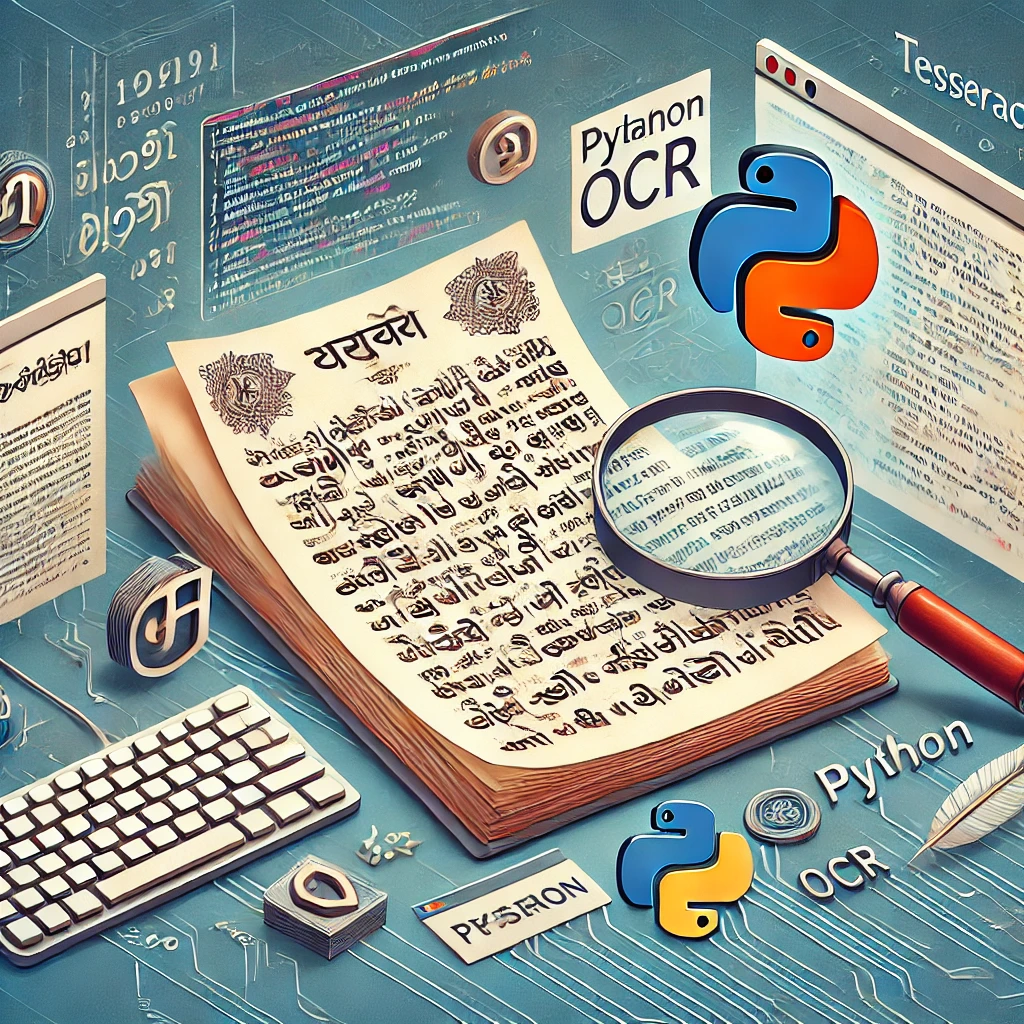Unlocking Text from Embedded-Font PDFs: A pytesseract OCR Tutorial
Extracting text from a PDF is usually straightforward when it’s in English and doesn’t have embedded fonts. However, once those assumptions are removed, it becomes challenging to use basic python libraries like pdfminer or pdfplumber. Last month, I was tasked with extracting text from a Gujarati-language PDF and importing data fields such as name, address, city, etc., into JSON format.
If the font is embedded in the PDF itself, simple copy-pasting won’t work, and using pdfplumber will return unreadable junk text. Therefore, I had to convert each PDF page to an image and then apply OCR using the pytesseract library to “scan” the page instead of just reading it. This tutorial will show you how to do just that.

Things you will need
pdfplumber(Python library)pdf2image(Python library)pytesseract(Python library)- tesseract-ocr
You can install the Python libraries using pip commands as shown below. For Tesseract-OCR, download and install the software from the official site. pytesseract is just a wrapper around the tesseract software.
pip install pdfplumber
pip install pdf2image
pip install pytesseract
Converting the PDF page to an image
The first step is to convert your PDF page to an image. This extract_text_from_pdf() function does exactly that-you pass the PDF path and the page_num (zero indexed) as parameters. Note that I’m converting the page to black and white first for clarity, this is optional.
# Extract text from a specific page of a PDF
def extract_text_from_pdf(pdf_path, page_num):
# Use pdfplumber to open the PDF
pdf = pdfplumber.open(pdf_path)
print(f"extracting page {page_num}..")
page = pdf.pages[page_num]
images = convert_from_path(pdf_path, first_page=page_num+1, last_page=page_num+1)
image = images[0]
# Convert to black and white
bw_image = convert_to_bw(image)
# Save the B&W image for debugging (optional)
#bw_image.save("bw_page.png")
# Perform OCR on the B&W image
e_text = ocr_image(bw_image)
open('out.txt', 'w', encoding='utf-8').write(e_text)
#print("output written to file.")
try:
process_text(page_num, e_text)
except Exception as e:
print("Error occurred:", e)
print("done..")
# Convert image to black and white
def convert_to_bw(image):
# Convert to grayscale
gray = image.convert('L')
# Apply threshold to convert to pure black and white
bw = gray.point(lambda x: 0 if x < 128 else 255, '1')
return bw
# Perform OCR using Tesseract on a given image
def ocr_image(image_path):
try:
# Perform OCR
custom_config = r'--oem 3 --psm 6 -l guj+eng'
text = pytesseract.image_to_string(image_path, config=custom_config) # --psm 6 treats the image as a block of text
return text
except Exception as e:
print(f"Error during OCR: {e}")
return None
The ocr_image() function uses pytesseract to extract text from the image through OCR. The technical parameters like --oem and --psm control how the image is processed, and the -l guj+eng parameter sets the languages to be read. Since this PDF contained occasional English text, I used guj+eng.
Processing the text
Once you’ve imported the text using OCR, you can parse it in the format you want. This works similarly to other PDF libraries like pdfplumber or pypdf2.
nums = ['0', '૧', '૨', '૩', '૪', '૫', '૬', '૭', '૮', '૯']
def process_text(page_num, e_text):
obj = None
last_surname = None
last_kramank = None
print(f"processing page {page_num}..")
for line in e_text.splitlines():
line = line.replace('|', '').replace('[', '').replace(']', '')
parts = [word for word in line.split(' ') if word]
if len(parts) == 0: continue
new_rec = True
for char in parts[0]:
if char not in nums:
new_rec = False
break
if len(parts) < 2: continue
if new_rec and len(parts[0]) >= 2: # numbered line
if len(parts) < 9: continue
if obj: records.append(obj)
obj = {}
last_surname = parts[1]
obj['kramank'] = parts[0]
last_kramank = parts[0]
obj['full_name'] = ' '.join(parts[1:4])
obj['surname'] = parts[1]
obj['pdf_page_num'] = page_num + 1
obj['registered_by'] = parts[4]
obj['village_vatan'] = parts[5]
obj['village_mosal'] = parts[6]
if parts[8] == 'વર્ષ':
idx = 7
obj['dob'] = parts[idx] + ' વર્ષ'
idx += 1
elif len(parts[7]) == 8 and parts[7][2] == '-':
idx = 7
obj['dob'] = parts[idx]
else:
print("warning: no date")
idx = 6
obj['marital_status'] = parts[idx+1]
obj['extra_fields'] = '::'.join(parts[idx+2:-2])
obj['blood_group'] = parts[-1]
elif parts[0] == last_surname: # new member in existing family
if obj: records.append(obj)
obj = {}
obj['kramank'] = last_kramank
obj['surname'] = last_surname
obj['full_name'] = ' '.join(parts[0:3])
obj['pdf_page_num'] = page_num + 1
obj['registered_by'] = parts[3]
obj['village_vatan'] = parts[4]
obj['village_mosal'] = parts[5]
if len(parts) <= 6: continue
if parts[7] == 'વર્ષ': # date exists
idx = 6
obj['dob'] = parts[idx] + ' વર્ષ'
idx += 1
elif len(parts[6]) == 8 and parts[6][2] == '-':
idx = 6
obj['dob'] = parts[idx]
else:
print("warning: no date")
idx = 5
obj['marital_status'] = parts[idx+1]
obj['extra_fields'] = '::'.join(parts[idx+2:-2])
obj['blood_group'] = parts[-1]
elif obj: # continuation lines
if ("(" in line and ")" in line) or "મો.ઃ" in line:
obj['extra_fields'] += ' ' + '::'.join(parts[0:])
if obj: records.append(obj)
jstr = json.dumps(records, indent=4)
open("guj.json", 'w', encoding='utf-8').write(jstr)
print(f"written page {page_num} to json..")
Every PDF has its own nuances that must be accounted for. In this case, a new serial number (like 0૧ or 0૨) in the first field signaled a new group when the subsequent field (surname) changed.
pytesseract is a testament to the evolution and advancement in IT technology. About a decade ago, reading or parsing a PDF image using OCR in a non-English language on a modestly configured PC or laptop would have been nearly impossible. This is truly progress! Happy coding, and let me know how it goes in the comments below.